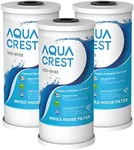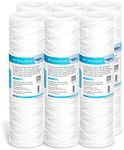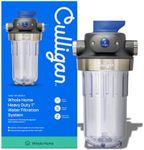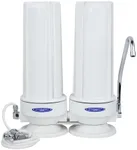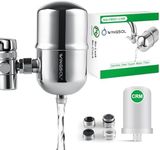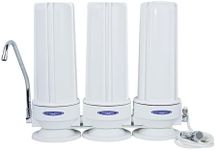Buying Guide for the Best Whole Home Water Filters
Choosing the right whole-home water filter is crucial for ensuring that the water you and your family use for drinking, cooking, and bathing is clean and safe. Whole-home water filters, also known as point-of-entry (POE) systems, treat water as it enters your home, providing filtered water to all faucets and appliances. To make an informed decision, you need to understand the key specifications and how they align with your specific needs. Here are the main factors to consider when selecting a whole-home water filter.Filter TypeThe filter type determines what contaminants the system can remove from your water. Common types include sediment filters, carbon filters, reverse osmosis systems, and UV purifiers. Sediment filters are great for removing large particles like sand and rust, carbon filters are effective against chlorine and organic compounds, reverse osmosis systems can remove a wide range of contaminants including heavy metals, and UV purifiers kill bacteria and viruses. Choose a filter type based on the specific contaminants present in your water supply.
Flow RateFlow rate, measured in gallons per minute (GPM), indicates how much water the system can filter at a time. This is important because it affects water pressure throughout your home. A higher flow rate is necessary for larger households to ensure adequate water pressure for multiple simultaneous uses, such as running a shower and a washing machine at the same time. For smaller households, a lower flow rate may be sufficient. Consider your household size and water usage patterns when selecting a flow rate.
Filter LifespanFilter lifespan refers to how long the filter will last before it needs to be replaced, typically measured in months or gallons. This is important for maintenance and cost considerations. Longer-lasting filters require less frequent replacement, which can be more convenient and cost-effective in the long run. However, the lifespan can vary based on water quality and usage. Assess your water quality and usage to determine the appropriate filter lifespan for your needs.
Micron RatingThe micron rating indicates the size of particles the filter can remove. A lower micron rating means the filter can remove smaller particles. For example, a 5-micron filter can remove particles that are 5 microns or larger, while a 1-micron filter can remove even smaller particles. If your water has fine sediment or you want to remove microscopic contaminants, opt for a filter with a lower micron rating. For general sediment removal, a higher micron rating may suffice.
CertificationCertifications from organizations like NSF International ensure that the filter meets certain standards for contaminant removal and performance. This is important for verifying the effectiveness and safety of the filter. Look for filters that have been certified for the specific contaminants you are concerned about. Certification can provide peace of mind that the filter will perform as advertised.
Installation and MaintenanceConsider the ease of installation and maintenance when choosing a whole-home water filter. Some systems are designed for DIY installation, while others may require professional help. Maintenance involves replacing filters and possibly cleaning the system. Choose a system that matches your comfort level with installation and maintenance tasks. If you prefer minimal maintenance, look for systems with longer filter lifespans and easy-to-replace filters.


